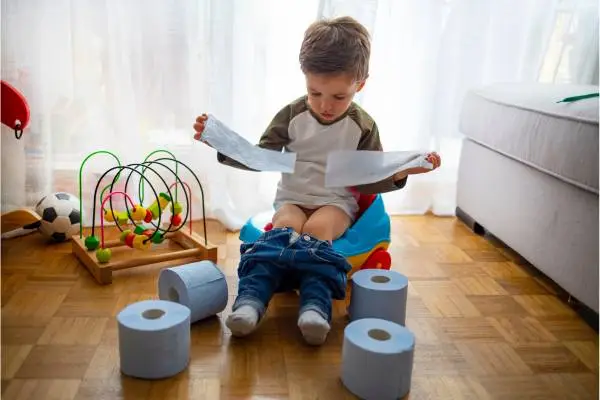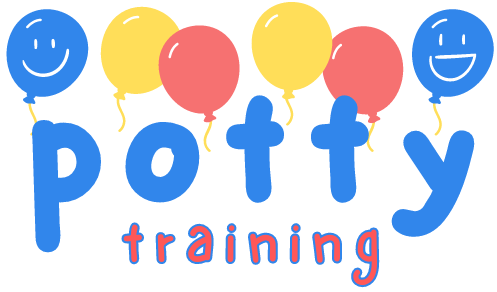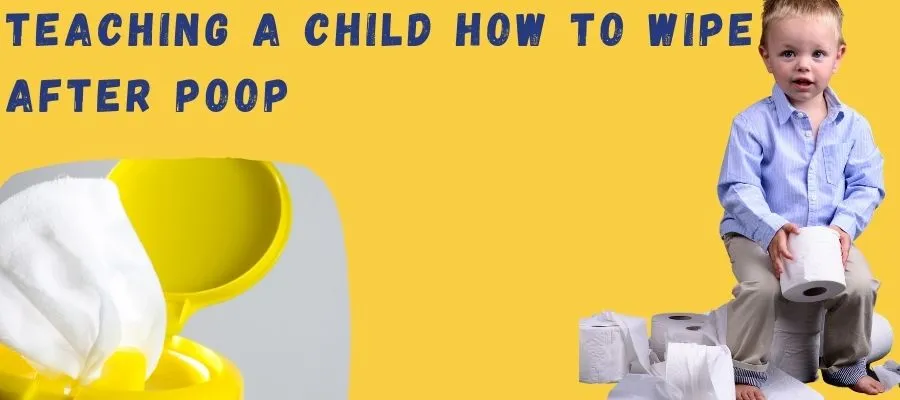Introducing your child to the concept of wiping after using the potty is an important milestone in their development. Not only does it promote good hygiene habits, but it also fosters independence and self-care skills. However, teaching this skill requires a gentle approach and plenty of encouragement.
In this article, I’ll simplify the process of teaching a child how to wipe by offering practical advice and strategies for a successful learning experience. From introducing the concept to reinforcing proper technique, we’ll cover everything you need to know to make this transition smooth and effective.
Got a little one under 2 years old? It’s all about gearing up for potty training readiness rather than diving into wiping training just yet! check out the article for potty training readiness.
Table of Contents

At What Age Should a Child Be Able to Wipe Their Bum?
There is no clear answer for this, kids learn to wipe their own bottoms at different ages. Usually, most kids start wanting to do it themselves between 3 and 5 years old. But some might be ready earlier, while others might need more time to learn.
It depends on things like how well they can move their hands and if they can comfortably reach their bottom. You should watch your child to see if they seem ready, and help them out as they learn. Just remember, every kid learns at their own speed, so it’s important to be patient and give them lots of encouragement.
In the beginning, it might be a bit messy, and they might get some poop on their hands, but they’ll get the hang of it eventually.

Choosing the Right Tools
Firstly, you need to choose the right supplies, which can really help make teaching your kids to wipe easier. Here are some tips for getting what you need:
Soft, Flushable Wipes: Consider using flushable wipes specifically designed for children. These wipes are gentle on sensitive skin and make wiping easier.
🎯Explore the fantastic deal on Kando Flushable Wipes, available on Amazon.
Child-Friendly Toilet Paper: If you choose to use toilet paper, opt for a brand that is soft and easy for small hands to tear. Avoid overly thick or textured toilet paper that may be difficult for children to use.
Step Stool: A step stool can help your kid reach the toilet and the toilet paper dispenser more easily. Choose a sturdy, non-slip stool that is the right height for your child.

Why Teaching Child to Wipe is Important
Ensuring that children learn to wipe themselves properly after using the potty is crucial for their hygiene and overall health. It is so important for children to wipe from front to back to prevent bacterial contamination and infections. This practice is especially vital for girls to avoid spreading harmful bacteria from the anus to the urinary tract.
Wiping Tips for Children
Now let’s get into successful tips and advice for teaching your child how to wipe themselves after using the potty.
➡️Starting the Wiping Process
I would suggest initiating the process a few months before a child begins preschool or kindergarten, allowing enough time for practice. Parents can introduce the concept by demonstrating how to use the appropriate amount of toilet paper, either by counting squares or pre-measuring a specific amount. Folding the toilet paper is encouraged to provide better coverage and ensure effective cleaning.
➡️Teaching Inspection and Hygiene
An essential aspect of teaching children to wipe is instructing them to inspect the toilet paper after wiping to ensure cleanliness. Parents should emphasize the importance of thoroughness and guide children in checking for any residue. Additionally, I would recommend incorporating flushable wipes for messier bowel movements, promoting better hygiene and cleanliness.
➡️Demonstrating and Modeling
Demonstrating and modeling the wiping-up process is an effective way to teach children this important skill. Parents can use dolls or stuffed animals to demonstrate proper wiping techniques, allowing their children to observe and imitate. By providing visual cues and guidance, parents can help their children develop the necessary motor skills and coordination for independent wiping.
➡️Using Visual Aids and Tools
Visual aids and tools can also be helpful when teaching children to wipe. Parents can use charts, posters, or books to reinforce learning and provide step-by-step instructions. Additionally, child-friendly wiping tools or wipes can make the process more manageable for children.
➡️Practice and Repetition
Like any new skill, mastering the art of wiping takes practice and repetition. Parents should encourage their children to practice wiping after each potty trip, providing guidance and support as needed. Over time, children will become more confident and proficient in this essential self-care task.
➡️Encouraging Independence
During the learning phase, parents may need to perform a secondary check to ensure thoroughness. However, once children consistently demonstrate proficiency, they can be entrusted with the task independently. This step is crucial for fostering independence and instilling confidence in children as they develop essential life skills.
➡️Incorporating Daily Habits
It is crucial to incorporate proper genital hygiene into daily routines from a young age. By teaching children these practices early on, parents can establish lifelong habits that promote cleanliness and prevent discomfort and health issues. Normalizing discussions about hygiene and bodily functions is key to helping children feel comfortable and confident in caring for their bodies.
➡️DIY Wipe Station
Create a DIY wipe station in the bathroom to empower your children and make wiping more accessible. Set up a small caddy or basket stocked with wipes, toilet paper, and hand sanitizer within easy reach of the toilet. Encourage your children to personalize the station with stickers or decorations, fostering a sense of ownership and independence.
When Your Child Won’t Wipe Their Bum?
Teaching children to wipe can sometimes be met with challenges and setbacks. Here are some common challenges you may encounter and strategies for overcoming them:
Resistance or Refusal
Some children may resist or refuse to learn how to wipe. In such cases, be patient and gentle in your approach. Offer incentives such as stickers or small rewards or provide choices like choosing their toilet paper, this will encourage them to participate in the process.
Difficulty with Coordination
Wiping requires a certain level of coordination, which some children may struggle with initially. Break down the process into smaller steps or you can provide physical support as needed, such as guiding your child’s hand during the wiping process.
Messiness
Accidents and messes are a natural part of the learning process. Keep plenty of wipes and cleaning supplies on hand, and remain calm and supportive when accidents occur.
You should also teach your child how to clean up any messes they make, whether it’s wiping up spills or disposing of soiled clothing. Encourage them to take responsibility for their actions in a supportive manner.
Lack of Interest
If your child shows a lack of interest in learning to wipe, try to make the process more engaging and fun. Use colorful toilet paper or offer to sing a silly song while they wipe.
Conclusion
In conclusion, it is also important to normalize discussions about hygiene and practicing proper wiping techniques. By following these tips, parents can help their children develop independence and maintain good hygiene habits throughout their lives.
Remember, teaching children to wipe themselves is a gradual process that requires patience and encouragement. By providing guidance and support, parents can empower their children to take ownership of their hygiene and build essential life skills for the future.

